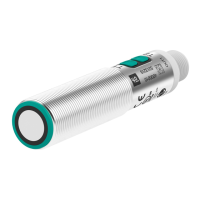UC***-18GS series
Description of Sensor Parameters
2020-11
55
8.4.4 Averages & Skip Count
You can use this parameter to control the depths of the average determination. M defines the
total number of measurements which are used to generate average determination. N defines
the number of measurements from the number of M which are not taken into account for aver-
age determination. These are the value/values with the greatest deviation from the measure-
ment result most recently determined. The current measurement result is calculated
arithmetically from the remaining data.
8.4.5 Weighting of Former Measurement
This parameter determines how much weighting in percentage terms the result of the previous
measurement result is given in the current evaluation.
The following formula applies:
Res
N
= (Res
N-1
x W + Meas x (100 - W)) / 100
Res = result
W = "weighting of previous measurement" factor
Meas = current measured value
Note
This parameter is only relevant and visible in the DTM if the "Evaluation method" is set to
"Average value."
Parameter name Access Value range
Averages & skip count Read/write • M=2, N=0
• M=3, N=0
• M=3, N=1
• M=4, N=0
• M=4, N=1
• M=5, N=0
• M=5, N=1
• M=5, N=2
• M=6, N=0
• M=6, N=1
• M=6, N=2
• M=7, N=0
• M=7, N=1
• M=7, N=2
• M=7, N=3
• M=8, N=0
• M=8, N=1
• M=8, N=2
• M=8, N=3
Table 8.22
Note
This parameter is only relevant and visible in the DTM if the "Evaluation method" parameter is
set to "Low pass."
Parameter name Access Value range
Weighting of former measure-
ment
Read/write 1 ... 99 [%]
Table 8.23

